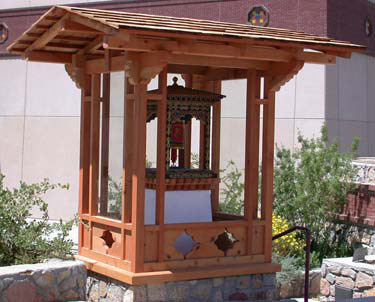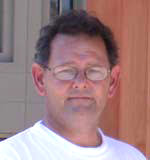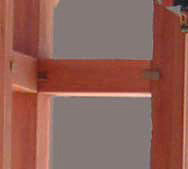 CENTENNIAL MUSEUM - CHIHUAHUAN DESERT GARDENS-THE UNIVERSITY OF TEXAS AT EL PASO
CENTENNIAL MUSEUM - CHIHUAHUAN DESERT GARDENS-THE UNIVERSITY OF TEXAS AT EL PASOCHIHUAHUAN DESERT GARDENS

Gift from the People of Bhutan, 2003
Prayer wheels are devices used by religious followers of the Buddha for spreading spiritual blessings and good will. Rolls of thin paper, imprinted with a mantra (a sacred text or invocation), are placed in a protective container usually made of brass or bronze, though more precious metals may be used, sometimes enhanced with mother of pearl, coral, or turquoise. Turning a prayer wheel symbolizes "turning the doctrine," referring to the first teachings of the Buddha, when he set the Wheel of the Law in motion, and accumulates virtues for the well being of mankind. Buddhism is the principal religion of the Himalayan country of Bhutan, whose unique architecture inspired the style of the campus buildings at UTEP.
There are many types of prayer wheels, although hand-held wheels are the most common. A person using the wheel sets it in motion by turning it in a clockwise direction. Each turn is the equivalent of reading the prayers within. Wheels may also be placed where they can be spun by the wind or by flowing water. This prayer wheel is similar to the ones placed at the
Of impressive size, such beautifully hand decorated wheels are protected from the weather by a roof and sometimes a protective watchtower-like enclosure. This beautiful structure was handcrafted from cedar wood without the benefit of nails using an intricate combination of largely hidden oak pegs in the style of Bhutanese artisans.
While this is a working prayer wheel that you are invited to turn, please do so gently and do not climb on or attempt to enter the structure.
The installation in the Chihuahuan
Desert Gardens


El Paso architect and master carpenter, Bruce Thacker, researched and constructed the enclosure using traditional Bhutanese methods. He developed the formulas for the three coats of natural clay that were applied to the base. The first rough coat applied to the wooden skirting consists of ground clay powder, sand and woodchip sawdust. The next coat or slip coat consists of sand and clay and the topcoat is clay, sand and flour glue. The base is whitewashed and the painted and exposed wood sealed. Decorative wooden corbels are faithfully reproduced as is the oak peg construction. Note the craftsmanship in the details of the few oak pegs that can be seen.